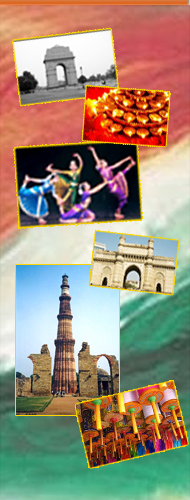

India, officially the Republic of India is a country in South Asia. It is the seventh-largest country by geographical area, the second-most populous country with over 1.2 billion people, and the most populous democracy in the world.
India became an independent nation in 1947 after a struggle for independence that was marked by non-violent resistance and led by Mahatma Gandhi.
The 487.6-million worker Indian labour force is the world's second-largest. The service sector makes up 55.6% of GDP, the industrial sector 26.3% and the agricultural sector 18.1%.
The value of India's international trade has increased sharply, with the contribution of total trade in goods and services to the GDP rising from 16% in 1990–91 to 47% in 2008–10. India accounts for 1.44% of exports and 2.12% of imports for merchandise trade and 3.34% of exports and 3.31% of imports for commercial services trade worldwide. India's major trading partners are the European Union, China, the United States of America and the United Arab Emirates.
In 2006–07, major export commodities included engineering goods, petroleum products, chemicals and pharmaceuticals, gems and jewellery, textiles and garments, agricultural products, iron ore and other minerals. Major import commodities included crude oil and related products, machinery, electronic goods, gold and silver. In November 2010, exports increased 22.3% year-on-year to INR85,063 crore (US$16.97 billion), while imports were up 7.5% at INR125,133 crore (US$24.96 billion). Trade deficit for the same month dropped from INR46,865 crore (US$9.35 billion) in 2009 to INR40,070 crore (US$7.99 billion) in 2010.
India is a founding-member of General Agreement on Tariffs and Trade (GATT) since 1947 and its successor, the WTO. While participating actively in its general council meetings, India has been crucial in voicing the concerns of the developing world. For instance, India has continued its opposition to the inclusion of such matters as labour and environment issues and other non-tariff barriers to trade into the WTO policies.[112]
The Indian subcontinent was identified with its commercial and cultural wealth for much of its long history.
The Indian economy is the world's eleventh-largest by nominal GDP and third-largest by purchasing power parity (PPP). Following market-based economic reforms in 1991, India became one of the fastest-growing major economies; it is considered a newly industrialised country.
A nuclear weapons state and a regional power, it has the third-largest standing army in the world and ranks ninth in military expenditure among nations. India is a federal constitutional republic governed under a parliamentary system consisting of 28 states and 7 union territories. India is a pluralistic, multilingual, and multiethnic society. It is also home to a diversity of wildlife in a variety of protected habitats.




